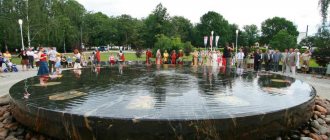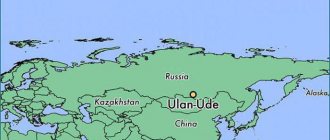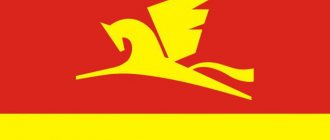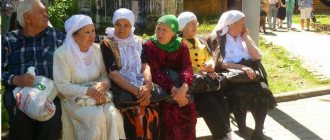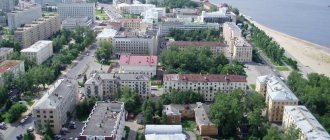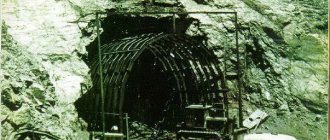Year founded: 1374
City Day is celebrated
on June 12
.
The station is the gate of the city
Kirov
(Khlynov, Vyatka) is the administrative center of the Kirov region. Located on the Vyatka River, 896 km from Moscow. A large transport, industrial and cultural and “peat” capital, a historical city of Russia.
The first settlements on the territory of present-day Kirov were formed presumably 2.5 thousand years ago. By the 7th century, the first nationalities of the Udmurt, Mari and Komi tribes were formed here. The main settlements were located along the banks of the Cheptsa, Moloma and Vyatka rivers.
First confirmed mention
about the city of Vyatka dates back
1374
in connection with the campaign of the Novgorod ushkuiniki against the main city of Volga Bulgaria - Bulgar.
In 1378, an alliance agreement was concluded between the Vyatchans and the Suzdal-Nizhny Novgorod principality, and from 1391 the city became the main residence of the Suzdal princes Vasily Dmitrievich and Semyon Kirdyapa, expelled from the Suzdal-Nizhny Novgorod principality after its conquest by Moscow. Ensemble of the Trifonov Monastery After the death of the princes in 1401, power passed to the Galician prince Yuri Dmitrievich.
Detachments of Vyatchan people take part in campaigns against the Golden Horde (1392, 1409) and in the war of Moscow Prince Vasily I with Novgorod (1417–1418). Due to its remoteness from the main Russian lands, the Vyatka land did not need an alliance with strong principalities and recognized only the patronage of the princes, remaining a self-governing territory. The people's council acted as the main governing body. The most influential group of the feudal class were the boyars, followed by the merchants and the clergy. The rest of the Vyatchans represented a free communal population and consisted of peasants and artisans.
Seraphim Church
Many famous names are associated with the name of Vyatka - the city was an exiled region, Saltykov-Shchedrin and Herzen, the architect Vitberg and the “iron Felix” Dzerzhinsky, the nephew of Alexander III Sergei Mikhailovich Romanov and many others lived here. The famous writer Albert Likhanov and cosmonauts Viktor Savinykh and Alexander Serebrov were born here. The famous Fyodor Chaliapin also has Vyatka roots. Natalya Goncharova and Isadora Duncan were here.
After the October Revolution of 1917, the Council of Supreme Administration of the province announced the non-recognition of the power of the Bolsheviks and the separation of the Vyatka province into an independent republic. In January 1919, Stalin and Dzerzhinsky visited Vyatka to check, finding out that Vyatka had no connection with the government in Moscow, most of the officials were former tsarist officials. As a result of the work of the commission, on January 19, 1919, a provincial Military Revolutionary Committee was created in Vyatka.
The famous Dymkovo toy
As of July 1938, there were 28 enterprises in the city, of which 13 were of union and republican significance, 7 of regional significance and 8 of local significance. Handicraft production was developed. During the Great Patriotic War, due to the evacuation of machine-building factories from Moscow and Leningrad, the industry of Kirov was mainly formed (modern ones, Avitek, Selmash, etc.).
On May 20, 2022, Russian President Vladimir Putin signed a decree awarding the title “City of Labor Valor” to 12 cities. Kirov was one of them.
Name Kirov
the city received after the murder in 1934 of a native of the city of Urzhum, Vyatka region, Sergei Mironovich Kostrikov (Kirov). An active participant in the October Revolution, however, was never in Vyatka itself. There are still debates in the city about what name the city should bear - Kirov or Vyatka.
In pre-revolutionary times, the city had a huge number of churches of beautiful architecture. Many of them were destroyed during Soviet times. One of the oldest cultural monuments of Kirov is the ensemble of the Assumption Trifonov Monastery, located on the embankment of the Vyatka River.
The tradition of the Velikoretsk religious procession is more than 600 years old (Photo: editor’s archive)
Other attractions of the city include the Church of Seraphim of Sarov, Alexander Park, Kirov Regional Art Museum. V.M. I am. Vasnetsov and others.
Today, more than 520 thousand people live in Kirov (as of 2020).
In addition to industrial enterprises, various folk crafts are developed here - the famous Dymkovo toy, products made from capocorn, Kukar lace, wickerwork, and ancient traditional embroidery.
One of the brightest events that takes place every year at the beginning of June is the famous Velikoretsk religious procession, which has more than 600 years of continuous tradition. Today the Velikoretsky passage has national significance.
Day of the city
in Kirov it is celebrated on June 12, simultaneously with another significant holiday - Russia Day.
General information and history of the city
Kirov, aka Khlynov, aka Vyatka, aka 43rd region, has always been the Russian rear. Located in the northeast of the European part of Russia, in the valley of the Vyatka River, it is still located far from main roads. And in the distant 1300s, when the Tatar-Mongol yoke was raging on the territory of our state, the Slavs fled inland - to this taiga region, so as not to fall into slavery.
They built small settlements - Kotelnicheskoe, Kovrovskoe, Orlovskoe, etc. For a long time, these actions were considered the starting point of Kirov history.
Meanwhile, the first mention of the Vyatka land dates back not to the 14th, but to the 12th century. It was then that Russian settlers discovered the Vyatka lands. But, apparently, they did not have enough strength to reach the Vyatka River, and they stopped at a small river - Khlynovka and named the city Khlynovo in honor of it.
Time passed, the city grew. Residents of Nizhny Novgorod, Ustyug, Tatars and Muscovites fought for the right to own his lands. For some time, the latter were victorious, and at the end of the 15th century, the local nobility was resettled in the Moscow region, and a Moscow governor was left in Vyatka. Only Muscovites tried in vain. Kirov was too distant from the main Russian lands and did not need princely patronage. The residents of Vyatcha recognized Moscow's power, but only formally. In fact, Khlynov remained a self-governing territory.
Kirov from a bird's eye view
And in the future, the Kirov region actively defended its independence. Thus, in 1917, residents of the Vyatka province did not recognize the power of the Bolsheviks and demanded that it be separated into a separate republic. But after a few years the Soviets had to submit, and for a long time Khlynov was simply a regional center of the Nizhny Novgorod region. And then in 1934 Vyatka was renamed in honor of the famous party leader Sergei Mironovich Kirov.
During the Second World War, civilians again fled to the rear city, and the state transferred industrial plants, weapons production and even the Leningrad Naval Medical Academy. The war is over. The factories remained on the territory of Kirov, but their main technical boom occurred during the Soviet era.
After perestroika, almost all production was closed, and Vyatka turned into an ordinary small provincial town, where the bulk of the population makes a living by resale or trade from their own garden. Fortunately, good temperature conditions contribute to the rapid growth of various crops.
Historical information
The largest city is Kirov. The population today exceeds 500 thousand people. And in 1590 (at this time the settlement was founded) this figure did not exceed 1000. However, the modern name of the city did not appear immediately. The settlement of the Slavs appeared much earlier. Historians mention the city of Vyatka, which was named after the river flowing in the immediate vicinity. The settlement appeared after 1821. The first mention of it in chronicles dates back to 1374.
The rapid development of the settlement was observed during the Russian Empire. In 1780, by decree of Catherine II, the Vyatka province was formed. At this time, the city's population began to increase rapidly. Villagers preferred to move closer to civilization. The Kirov (Vyatka) area also began to grow. In 1727, the first elementary school was already opened. Children began to receive quality education. Soon the official coat of arms of Vyatka was established.
In 1744, the city's postal service began to develop. Communication was established between Moscow, Siberia and Kazan. In 1806, construction of a bridge across the river began. Thanks to this, new opportunities have emerged for the development of industry and the city’s economy. In 1802, the first hospital with 10 beds appeared in the village at the center for the disabled.
Significant changes in the city took place during the October Revolution. In December 1917, the Vyatka Council completely took control into its own hands. At the same time, the first issue of the newspaper “Vyatskaya Pravda” was published. In 1929, administrative reform took place. The authorities abolished the division of the country into provinces. The city became part of the Nizhny Novgorod region. In 1934, it was decided to rename the city in honor of the revolutionary S. M. Kirov. Two years later, the Kirov region appeared on the maps.
Climate and ecology of Kirov
The Vyatka climate is worth talking about separately. Of course, Kirov is a northern city, and winter here lasts from October to March, but in the summer it is possible to grow something. There are few temperature fluctuations in the spring (rather, it freezes at around 15 degrees and does not move further), and the seedlings do not freeze, but develop into a high-quality fruit-bearing plant. In the summer it rains a lot, so the crops do not dry out, and summer residents reap a good harvest.
But only gardeners are happy about this weather - ordinary people, and especially young people want a hot summer. It’s just that in June and July there are stable thunderstorms, and in August there are real downpours. Meteorologists forecast normal weather every week, but it turns out to be rain and wind.
Smoke from thermal power plant
The ecology is also in trouble. No matter how hard you try, you can’t change the water in Vyatka. And the river here is dirty and scary. The bottom is not visible even where the water is waist-deep, chocolate wrappers float, and the Sanitary and Epidemiological Station finds some sticks from time to time.
But this is a debated side of the issue. They don’t talk much about discharges from local factories, but they exist. The Kirovo-Chepetsk biochemical plant (Kirovo-Chepetsk is a suburb of Kirov) daily dumps industrial waste into Vyatka. Due to wood processing industries, a large amount of sawdust and wood chips enter the river, and the water becomes contaminated with wood decay products.
The match factory is not lagging behind its colleagues and is actively polluting the only drinking water reservoir! Yes! In Vyatka they not only swim, they also drink! Of course, there are treatment facilities. And local residents were assured of the special power of chlorination. From time to time, respectable guys appear on local television, claiming that the water from the tap can never be purer! But for some reason, the filters become unusable in less than a couple of months; after a few hours, sediment forms in the carafe with liquid, and the bathtubs turn yellow immediately after purchase.
Someone came to the rescue in time and made a business out of the bad Kirov water - they began selling “clean” water in 5-liter flasks. Automated water kiosks are located in all areas of the city. Supposedly this is water from the local mineral spring “Nizhne-Ivkino”. Well, yes, it tastes much nicer than “municipal” H2O, you can drink it without boiling and safely give it to children. 5 liters of this miracle water cost 12 rubles. You can take it for cooking and tea, but you still have to wash in your own chlorinated one.
However, all problems with water are blocked by air. The Kirov region is a forest region. It's wonderful to breathe and live here. About five years ago, the city was strained by a biochemical plant, and when the wind blew from Chepetsk, local residents were ready not to go out, just so as not to hear the “aroma.” But recently the stinking streams have stopped, either the wind is no longer blowing from that direction, or the plant employees have repaired the cleaning mechanisms. So in Kirov you can breathe easily and freely - an ideal place for retirees - here you have both nature at your side and the city with all its delights in the form of supermarkets and cinemas.
What to see in Kirov: the main attractions of the city
Everything is fine with the sights in Vyatka, according to experienced tourists. Museums, parks, ancient buildings and temples, numerous architectural and historical monuments - all this can be seen here. Unfortunately, the Vyatka Kremlin has not survived to this day. But the ensemble of the Trifonov Monastery, which was founded in the 16th century, has been perfectly preserved.
The calling cards of the city can be considered local kvass, as well as two folk crafts: openwork Vyatka lace and the famous Dymkovo clay toy.
There are quite a lot of interesting sights in Kirov. But we will try to highlight the ten most important:
- Assumption Tifonov Monastery.
- Alexander Garden is a real masterpiece of park architecture.
- Temple of Seraphim of Sarov (1907).
- Museum of Dymkovo Toys.
- Art Museum named after Vasnetsov.
- Museum of Cosmonautics named after. K.E. Tsiolkovsky.
- “Progress Gallery” is a center of contemporary art.
- Kirov Botanical Garden.
- Estate of merchant Bulychev (early 20th century).
- Kirov Planetarium.
Population of Kirov
The bulk of the population of Vyatka is the older generation. Young people are trying to leave Kirov. Those who are behind the scenes and more insolent leave here after graduating from school or university. And the funny thing is that for some reason they mostly go not to Moscow, but to St. Petersburg or abroad. And the Kirov residents are very kind, warm and pleasant people. They were only slightly spoiled by the “car-alcohol” issue.
On Theater Square
Now in the provinces, many people buy documents and start driving a car, practically not knowing the traffic rules. They behave defiantly and do not pay attention to traffic lights and signs. Someone gets behind the wheel drunk. The situation is typical for all of Russia, and Kirov did not escape it either. Almost every week in a city with a population of 500 thousand there is a fatal accident.
But if you don’t look at the police reports, then everything is fine and little different from larger populated areas. There are quite friendly salespeople in the shops, classic “Einsteinian” teachers in the institutes, and pretty old ladies in the libraries.
They also have their own “golden” youth – the children of local bigwigs. As a rule, these guys study in lyceums and gymnasiums in Kirov, and then go abroad, bypassing Moscow.
Also, Kirov is full of gifted schoolchildren - winners of all kinds of Olympiads and competitions, 100-salers in the Unified State Examination - they enter leading Russian universities, and, as a rule, never return to Vyatka.
However, Kirov is a regional center, therefore, as in big cities, applicants, workers and simply people who are tired of living in a small village flock to it every year from all over the region. They rent an apartment or buy housing on credit, live in student dormitories and consider Vyatka a completely acceptable place.
And not all indigenous residents leave for large centers - some remain in their city or migrate to neighboring regions (Perm, Komi Republic, etc.), have children and lead a quiet, calm life with classic trips to the country, a mortgage and telephone conversations “about nothing.” But no matter how a Kirov resident looks, no matter how he is dressed, he can always be recognized by his calm, smooth speech, by his specific Vyatka okan. Of course, if you live in another place for a long time, the dialect will disappear, but in Kirov itself you can hear it everywhere.
Administrative structure
Kirov is divided into four urban districts. The largest population is in the Leninsky district. There are also the following non-municipal entities: Novovyatskoye, Oktyabrskoye and Pervomaiskoye. The main territory is formed by the coastal part in close proximity to the Vyatka River. The city is also adjacent to rural microdistricts - Pobedilovo and Lyangasovo. A total of 134 settlements (mostly villages) are subordinate to urban areas.
Kirov is a unit of local government. The main regulatory document of a settlement is the Charter of the municipality. The document was last revised in 2005. In accordance with this charter, the main governing bodies, as well as city services, are formed. The main body of local government is the Kirov City Duma. It consists of 36 deputies. It is these people who are responsible for the social protection of the population of Kirov. The Duma adopts the city budget and develops plans for the economic and cultural development of the locality. In addition, the Duma approves the head of the city. This is the highest official of the municipality. In 2022, the role of the head of the city was performed by Vladimir Vasilyevich Bykov.
Regional authorities and the legislative assembly also function in Kirov. These are the most important organs of Kirov. The standard of living of the population is controlled precisely thanks to their work.
Districts and real estate of Kirov
Map of Kirov
Administratively, the city is divided into several districts. If you believe Wikipedia and the hot water shutdown schedule, there are four of them - Oktyabrsky, Leninsky, Pervomaisky and Novovyatsky. Shops, clinics and kindergartens are located evenly in each part of the city. But the average Kirov resident remembers this zoning only when he has to go to the housing office or passport office. In reality, there are more districts, their names are different and, unfortunately, the standard of living is also different.
View of the center of Kirov
There is a city center. This is Theater Square, a theater show. A beautiful place with a fountain, a quiet square, city hall, a monument to Lenin, a theater, a local humanities university and a basketball court taken from nowhere. Either this is someone's cruel joke, or complete idiocy. Agree, it’s a little rustic to play with a ball in front of the Duma! But, nevertheless, the area is beautiful and well-groomed.
theatre square
You won’t find a gopnik in sweatpants here, but you can easily find a pretty old lady or a young mother.
The houses in the area are also “intelligent” - there are practically no Khrushchev-era buildings, either Stalin-era (they are also called full-size ones here), or a new layout. Therefore, apartments in this area are relatively expensive; a one-room apartment of 32 square meters can be purchased from one and a half million rubles. Moreover, there is practically no real estate left on the first floors - they were sold out and shops were created.
In general, this is a disease of the whole of Kirov - the lack of life on the first floors, you walk around the city, and there are only signs around. Well, how can there be so many retail outlets in a city where the average salary is 19 thousand? Who takes what from them?
But this is not so important, it is important that after the Teatralka we go down Engels Street to Oktyabrsky Prospekt, turn left and find ourselves in the area of the Oktyabrsky Market and Tank.
If everything is clear with the market (it just exists and they’ve been selling all sorts of junk on it for the last twenty years), then it’s worth mentioning separately about the Tank. This is a monument “from the Kirov residents to the front” at the very end of Oktyabrsky Prospekt in the form of a T-34. The figure is monumental and so historical that three generations of Kirov residents do not remember what was in that place before him. It does not interfere with anyone’s life; rather, it separates the zone of the center and the non-center. The center is what is closest to the monument to Theater Square, not the center - everything that is further away.
The same tank
If you turn left at the Oktyabrsky-Engelsa intersection, you can get to the Scarlet Sails cinema area - it differs from Tank only in name - the infrastructure is the same.
In general, in the middle of the entire Oktyabrsky Prospekt there is an alley, along which beautiful trees grow, there are benches with sawed-off backs (so that all sorts of smart people don’t climb onto the benches with their legs) and cars rush around at high speeds for Kirov.
The houses here are different, but mostly five-story buildings. Moreover, if you are thinking of buying an apartment on the avenue, you will be surprised. Recently, a Khrushchev apartment with cockroaches (30 sq.m.) costs the same as a full-size one-room apartment (38-42 square meters) - 1300 rubles. What is this connected with? Most likely, with an increase in communal services and the migration of old women to small apartments. Lonely grandmothers don’t need square footage, they need a quiet old age, and for the square footage their fat increases. The demand for Khrushchev buildings has increased and their prices have risen. Let's hope it doesn't last long.
In addition to old houses, in this part of the center there is also elite housing - ten-story P-44s, which were built about 10 years ago. A one-room apartment in such a house will cost about two million - but there will be no problems with communications and drunk neighbors.
In 2012, a huge residential complex was commissioned on Engelsa, 82 - a beautiful multi-storey building, stylish design, huge square footage. But - but! It passed the state commission, but there are more than enough engineering problems in this elite, and people prefer not to renovate the purchased apartments, but to sell them in rough finishing (from 1,700 rubles for a one-room apartment). But who needs them if the credibility of the house and the developer company has been shaken?!
If you walk along Oktyabrsky Prospekt, you can get to Vorovskogo Street - the area of TSUM and Circus, here in the early 2000s there were the main shopping centers - the department store itself, Rosinka and Dom Byta. Now they have not lost their relevance, but rather faded into the background. When the Globus company occupied the grocery niche in Vyatka, it very quickly built a large shopping center further along Vorovskogo (more about that area a little later). There were the first escalators, mirror elevators, there was active advertising of the store - and many trademarks migrated there.
But the Central Department Store still remains a fundamental building. Many consider it, and not the Teatralka, to be the center of Kirov and ask for 1.5-1.7 million rubles for their Khrushchev buildings on Vorovsky. The strangest thing is that there are those who believe them and pay this money. Anyway.
TSUM
Oktyabrsky Avenue ends with the fundamental construction of a high-rise residential building (if the end of the world does not happen, then maybe they will even have time to complete it) and a railway station. This area is called – ZhD or Druzhba (the cinema again! – Kirov residents love cinema, what can you do!).
Nothing special can be said about him. Dirty, filthy, lots of stray dogs. The houses there are different, and the cost of apartments is twenty percent less than in the central ones. But sometimes it’s better to take out a mortgage than to get hit on the head in the evening.
Far from the center, not far from the railway station, another area is growing - "Chistye Prudy", the older generation remembers it under the name "Uchkhoz" and avoids it - once there were barracks and two-story Khrushchev buildings there. But time passes, the barracks were demolished, the developer bought the land and built a stylish residential complex - it is bright, lively, with elevators and parking. The house is good, but the prices are also good - from one and a half million for a rough one-room apartment, and this is far from the center. But it is environmentally friendly.
Across a small forest from Uchkhoz there is another new quarter, Sunny Beach. Apartments there cost the same, the houses are just as perfect, only the windows do not overlook the wasteland, but the Vyatka River, which increases its popularity.
Chistye Prudy
If we’re talking about new residential complexes, it’s worth remembering the houses on Zavodskaya, a supposedly new area. The buildings are good, but the location is lousy. The complex is surrounded on three sides by industrial zones and fences with the sign “Beware of the evil dog.” Few Kirov residents would dare to buy an apartment there - no one wants their children to play near brutal bull terriers.
Sometimes it seems that Kirov developers have recently forgotten that it is possible to combine both a good location and the quality of an apartment. Their successful shots took place ten to fifteen years ago, when massive construction was underway in the southwestern region. That’s where they created classic residential neighborhoods, where poor young people went, communal apartments from the center settled, and housing was affordable.
Now the cost of apartments in South Western Russia and the center is approximately equal and differs by a hundred thousand. But the area is actually vibrant and dynamic. This is where the “Globe”, which was mentioned above, was built, and this is where the first McDonald’s in Kirov was opened!
Four districts are considered the most criminal in Kirov: Lepse, Comintern, Fileyka and Novovyatsk. Once upon a time, apartments were given to ordinary factory workers without education or special ambitions. The apartments here were small, small-sized or Khrushchev-era - they cost little then and now. This is perhaps the only place in the city where you can actually buy an apartment for 800 thousand rubles.
YZR
Green embankment and Alexander Garden. This is by no means the center, but rather the outskirts of the city. There is a prison and sewer drains here, but it is a very beautiful place, from where the entire river and the opposite bank are visible in full view. The houses in this part of the city are mixed - some are elite (price per square meter starts from 50 thousand rubles), and there are the opposite - slums, where the first floor is located at ground level.
After Moscow, Kirov seems like a nice village where everyone lives and lives on pennies. But that's not true. There are a large number of expensive foreign cars on the streets, and several thousand mansions have been built outside the city limits. Moreover, they are mostly located on the other side of the Vyatka (across the bridge from Kirov). The farthest building is elite houses in Borovitsa - the Mashkachi partnership (20 km), the closest is Bolshaya and Malaya Subbotikha.
City outskirts
Land in the suburbs of Kirov is inexpensive (about 15 thousand rubles per hundred square meters with all communications), and not only the local rich, but also ordinary people can afford a house in nature. They buy a plot of land and build a house. Some do it themselves, others hire specialists. A log house will cost 500 thousand, a large brick one - a million. In total, this is the price of a one-room apartment, but nature and no neighbors!
Popular message topics
- Computer graphics
Computer graphics includes four main types. Raster graphics, vector graphics, fractal, and also three-dimensional graphics. - Economy of China
China is one of the most ancient and rather mysterious countries in the world. For a long time, China's economy seemed to be not in the best conditions of development. Still, China tried to reach a high level and increase the supply of goods - Horse pet
The horse is one of the most beautiful and noble animals. It was domesticated four thousand years ago. Soon he modified her appearance according to his plans. And now all kinds of breeds appeared before us - from miniature ponies
Housing and communal services and other infrastructure
Utility workers in Kirov have become completely insolent. Housing and communal services tariffs are rising throughout the country, but only in Vyatka they managed to double them! But, however, the townspeople rebelled and somewhere at the beginning of 2012 they wrote to Prime Minister Putin at that moment about the lawlessness that was happening. The election race was going on, and such a letter could not go unnoticed. The regional governor was reprimanded, and tariffs dropped to the average level - about a thousand rubles per person.
But the general state of public utilities, of course, is not encouraging. Soviet-era houses are dilapidated, facades are crumbling, and roofs are leaking. The residents of the top floors are unlucky - the ceilings of their apartments are covered with mold, and in some places they have completely collapsed due to constant dampness. Housing and communal services just throw up their hands, patch up attics every year, sue angry residents, but do not compensate for the consequences of leaks and are not going to spend money on a full-fledged overhaul of houses. In general, this organization does not particularly like construction work.
In Kirov (in the center!) there are many houses where there is no central gas supply - once every few months the residents of such “full-sized” houses are delivered cylinders! And how many letters and requests were written!
What's this! Some houses cannot be connected to central heating - their residents pay huge bills in winter for heating the apartment with electricity or gas. Housing and communal services remember that they need to collect monthly fees, but forget about their obligations.
Old houses are located right inside new neighborhoods
Also, utility workers don’t like to systematize anything and don’t see the point in having a proper file cabinet. How else can we explain the fact that there is constant confusion in receipts - some will be charged less, some more than they should be, and some will turn from an owner of square meters into a tenant of social housing? And every time you have to go to the organization, sort out the documents, write a complaint, etc. We remind you that this is the 21st century, but in the Kirov housing and communal services there are antediluvian computers, apartment cards are not entered into a common database, and girls sitting in the window are simply “not in the know” and it can be very difficult to get an intelligible answer from them to your question.
But it’s not just home improvement that’s suffering. If you look at the roads, it becomes scary. As in one joke - I wish the one who came up with patches on asphalt to wear darned socks for the rest of his life. Kirov has never been known for its smooth roads - it generally stands on several hills - the streets “dance”. No, if we put in a normal covering, maybe then there will be fewer accidents? But Kirov residents are not looking for easy ways. Every day, utility services fill holes in the roads - there are a lot of “holes”, but the city budget does not plan to purchase new asphalt.
The Governor's car is also forced to look for a parking space.
So, due to bad roads, even in such a small town as Kirov, traffic jams appeared. But it’s not because there are a lot of cars and everyone is in a hurry to get somewhere that the accident is to blame. Some car will get stuck in a pothole and block all traffic. So you need to plan your time in Vyatka with plenty of reserve. Moreover, there are no other options other than ground transport here. The city is too small for the metro; they didn’t even allow a tram into Kirov; they decided that trolleybuses, buses and minibuses would be enough for local residents. In principle, there are enough of them, they run often, but after 22.00 you have to take a taxi - city transport stops operating at this time.
The kindergarten issue in Kirov is acute. There are traditionally few preschool institutions. Instead of building new kindergartens, the administration is renovating the old ones again! In principle, it’s not bad, it’s better for kids to frolic in clean, modern rooms, but this doesn’t make it any more spacious. And you can get to heaven for preschoolers either according to the queue or through connections. If the child’s parents do not know each other, and they did not worry about the kindergarten in advance, the grandmother will have to look after the baby, or the mother will return late from maternity leave.
But there are many schools in Kirov. In each district (if you look not at the traditional, but at the specific classification) there are at least three such educational institutions. But, of course, they all differ from each other in their level of education and composition of teachers. As in Moscow, they practice electronic queuing for classes. Those. a parent can enroll their child in absolutely any school, regardless of their place of residence. But there they will look at how full the parallel is, and decide whether to take such a student or not.
It is clear that the strong schools are overcrowded, while the “lagging behind” schools have empty desks. But here the local lyceums stand apart. This electronic recording did not affect them in any way. If you want to study with them, you will have to take exams. Even first-graders are not allowed to pass without testing. But the enrollment rate at Kirov lyceums is colossal - all their graduates become students of good Russian universities.
Transport
The population density of Kirov is quite high. The area of the city cannot be called small either. Therefore, public transport is well developed here. Kirov is also a major hub in terms of intercity communication. The Vyatka federal highway runs in close proximity to the city. The Kostroma-Kirov-Perm highway also passes here. Moreover, there is a regional highway that connects Kirov with Nizhny Novgorod.
Kirov is also one of the largest railway junctions in Russia. It belongs to the Trans-Siberian Railway. From Kirov you can get to Moscow, Vologda, St. Petersburg, Perm, and Nizhny Novgorod without a transfer.
The city has a developed internal transport infrastructure. The total length of city roads exceeds 500 km. There are 5 multi-level interchanges in the village.
The basis of public transport is Kirov buses and trolleybuses. The first trail system was developed in 1934. Currently there are 45 bus routes. The trolleybus sector is less developed. Currently there are only 13 routes operating. The Kirov Employment Center offers free training for bus and trolleybus drivers. However, young people do not want to choose such a profession due to low wages.
Where to go to work, or city-forming enterprises of Kirov
Some Kirov residents prefer to study and work in their hometown. In principle, you can find a good bread place here. There are several, “Mayak”, the same Biokhim, who are interested in the influx of young specialists and provide them with luxurious working conditions. This includes a good salary by Kirov standards, and all kinds of cash grants, and subsidies for the purchase of housing. Let us repeat - young people are trying to leave Vyatka, and if the “golden” head nevertheless decides to stay at the Kirov enterprise, they will groom and cherish it.
Avitek
To get paid well, you need to work on the resource. This is either communications, production, construction, government or similar things. Therefore, organizations in which it is beneficial for Kirov residents to work belong to similar areas. True, recently the central offices of strong Kirov organizations have been moving to Nizhny Novgorod - closer to the capital. For example, Rostelecom is a provider of telephone and Internet services in Kirov. A state-owned enterprise. Its employees receive a flat salary (from 20 thousand rubles + bonuses) and do not face the problems of delays and non-payments. Many would like to work there, but there is a strict selection and age limit.
And recently there have been layoffs at the company. Half of the processes were automated, and the organization of telephone services was transferred to Nizhny.
Those who are employees of organizations responsible for supplying basic communications to homes: electricity, water and gas also earn good money. These are Kirovelektrosvyaz, Vodokanal and Kirovregiongaz. In the cases of these companies, again there are no delays in monthly payments, paid vacations and sick leave are provided.
Some Vyatka construction organizations (for example, Severstroy) can also be called stable places of work. But when applying to such companies, you need to look at their track record - unfortunately, a lot of enterprises remained in debt to their employees - and the courts and bailiffs could not help the deceived people in any way - confiscations and inspections showed that the company was bankrupt and it never had anything did not have!
For those who do not have a higher education or who are not attracted to work in a technical company, the doors of large stores and shopping centers in the city of Kirov are open. People will always eat, so joining the local grocery chain Globus is a good step. The official salary there is small, but an ordinary salesperson receives about 15 thousand in an envelope.
Globus shopping center in Kirov
Payments are stable, since the company has large income. Lately, the Moscow Pyaterochka has been trying to interrupt it. Capital entrepreneurs bought several areas in the city center. They say they pay the same. Working conditions are not very different from Globus, but, probably, Kirov’s Pyaterochka is in the red for now. For a long time she resisted and did not want to sell the products of local dairy, bread and meat production, so they did not particularly go to these stores. Moreover, the quality of services did not differ from Globus, but the packages (at the ready of the local grocery chain) at the checkout of Muscovites were paid.
Now “Pyaterochka” has worked on its mistakes and on its shelves there are products of the local bagel and confectionery plant - “BKK”, meat production “KMK” and fermented milk products of the “Vyatushka” brand.
By the way, it is also profitable to work in the above companies. Every year, Kirov products take some places in all-Russian competitions and are sold not only in the 43rd region, but in neighboring regions. This means that the employees of these enterprises are loaded to capacity, but also receive a corresponding, far from small salary.
In general, there are many companies in Kirov. And, if young people went into production, and not into managers, there would be no shortage of labor. Everyone would receive a decent income, and not measly handouts for sitting in the office. Kirov is not Moscow. Resales and telephone marketing will not work in a small town. In a quiet province, to achieve success, you need to work on the resource - this is the easiest way to earn a living.
Healthcare
The area of Kirov is impressive (more than 160 sq. km). It is no coincidence that there are many hospitals of national importance, as well as private clinics. You can hear a lot of good reviews about the city arrhythmology center. This is a government institution where people with cardiovascular diseases can receive quality care. Not only the population of Kirov, but also residents of other Russian settlements are accepted for treatment. If you have a health insurance policy, services are provided free of charge.
The Rosplasma blood plasma processing plant can be considered the pride of Kirov. This is an organization that collects donated blood, further studies and processes donated material. Based on the obtained substances, drugs necessary for the treatment of many diseases are manufactured.
Crime in Vyatka style
Kirov is such a quiet province that even in the famous 90s nothing terrible happened here. No one was rolled into concrete or guarded. Local businessmen quietly divided their zones of influence, traded, shuttled, opened new stores and built residential buildings.
Vyatka is not a serious criminal area; all crimes, both then and now, happen here due to stupidity and drunkenness. The 43rd is a poor region, even officials, let alone large mafia structures, are not interested in stealing there!

